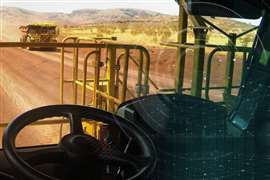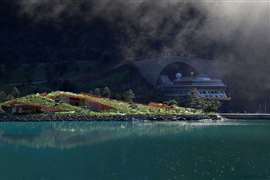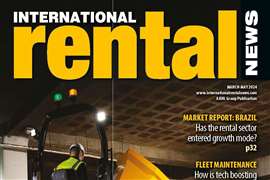The future of Manitou
14 December 2017
Manitou Group has growth on its horizon. Lindsey Anderson and Euan Youdale visited the company’s facilities and got the scoop on the coming 18 months.
Manitou has major ambitions when it comes to its aerial platform segment and sees it potentially outstretching its telehandler sales, for which it is globally known. A sign of these intentions came at APEX 2017, in Amsterdam, when Manitou first made hints at bringing its aerial work platforms to North America.
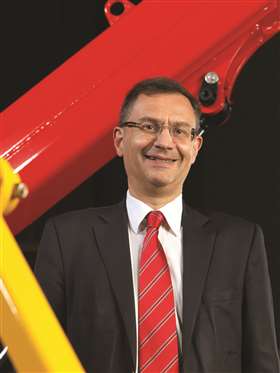
Francois Desbriere, head of product marketing management for Manitou Group, told AI and ALH that the upcoming changes with ANSI and CSA standards would allow for “more competition within the US” and that Manitou would “soon” bring its boom line to the North American market.
AI and sister magazine ALH visited Manitou’s headquarters in Ancenis, France, and the company’s aerial manufacturing facility in Cande, France, recently, to learn more about the company’s global visions and ambitions. We sat down with the company’s chief financial officer, Hervé Rochet, to discuss the coming 18 months and how the market for aerials and telehandlers will fare.
You have been developing the aerial work platform area. You had the new 22m at APEX. What are your plans?
AWPs are an important product for Manitou. Manitou started in 1995 in this market. It has been a long journey to stabilise our product and get organised. But over the last seven or eight years, it’s been growing. It’s something that we really want to expand as this is a product which is absolutely complimentary (with telehandlers)and there is a lot of synergy for us to continue in this market. This is where we are developing and accelerating in to get a stronger position.
Over the last couple of years, we have expanded our range from the high-end to the lower-end – Mango. We introduced that three years ago. The 280 TJ was four years ago. We are expanding in all different segments. We want a better grip of the market. We want a wide product range to better serve the needs of different customers.
And, also, geographically, we want to expand. Our AWPs have mostly been distributed in Europe; we are also present on other continents but we were not yet in North America. We want this product range to be global so we have decided to be present in the US at the beginning of this year. We will do this step by step. We will adapt the product to make them in line with American norms.
Will the upcoming ANSI/CSA standards help bring more equipment over to the US?
Yes, yes absolutely. This will be an important step for Manitou, to move in this direction. We are a family owned company. We are long-term driven. It’s a step-by-step approach. There are a lot of steps, but we are confident that we can make them and possibly take a good portion of the States.
Is your plan to have a certain product line or the whole range in the US?
They won’t come all together. They will come separately. It’s just a question of adapting them for America.
Is there a specific boom type – articulated, telescopic – that you see North Americans wanting more?
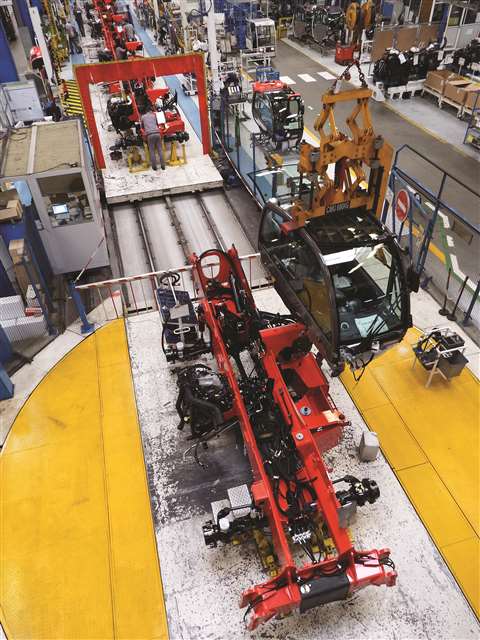
The market is not the same [in the US as Europe] so we have to learn. The market in the US is much more boom-focused [than telehandler-focused.] A boom is much more common in the US. Our complete range is not boom-focused. We have only become boom-focused over the last four or five years. We continue to work in that direction.
What percentage of your business is in North America at the moment?
Last year, North America was a little less than 20%. It’s around 20% now. Europe was stronger than the US last year.
Is there a plan to expand the telehandler line in North America as well?
For the telehandler, there are two categories. For the US we have to have US-designed telehandlers. So we continue to develop these product ranges. We have had a facility in Waco, Texas, for forklifts. Also, in the States, we have rotating telehandlers. Rotating telehandlers are growing in the US. We also have the ag business segment, which is a niche market for telehandlers in the US. It’s going slow, but there are opportunities. Again, it is a long journey. We keep pushing. Some models are designed for the ag business - they are made to compete with loaders. We are here and we are trying to convert some users of loaders into this type of application. We also have truck mounted forks, where the fork is on the back of the truck, in the US. This is also a niche market.
Going back to MEWPs. How much do you want to broaden your range? Other product types? Scissors?
For the time being, we have no plan to go into scissors. We see how it works because it is a very complimentary product. A full range would include scissors, but in Europe we have “solved” the issue by getting a cross-agreement with Terex [Genie.] We are distributing Manitou products, which are Terex scissors, in Europe. This has been implemented since 2011. It’s a way for us in Europe to cover the lack of scissors in our range. It’s not the best way to win the market because it’s very competitive, but it provides an opportunity to get more equipment to our dealers.
We are aware that not producing our own scissors might seem like we are ‘missing something’ in the access world.
In the future, will you be a main-line provider of access to compete with Terex or JLG, or would you keep it as a complimentary product to telehandlers?
We are already competing with all of the companies. What is sure is that our position in Europe in the market that we address is strong. It’s more a question of the DNA of the company. The DNA of Manitou was more telescopic-centric. Year-after-year, the growth of access is the fastest for the group. This is where we have the strongest potential. We continue to invest, develop and increase our market share in the different segments of aerials. In some areas, it’s already in effect, like in Europe. Outside of the US, we have different kinds of presences, so we continue to strengthen them. In the States, for non-US products to enter, it’s always a long journey, so we work towards that. We started in the States in the early ‘80s and we will continue to grow.
Do you see, globally, access equipment eventually equaling the numbers of telehandlers that you’re selling?
If you look only at the market potential, yes. The market is much bigger than telehandlers. That’s where we have strong opportunities to grow. The product range needs to be strongly recognised. It has to be competitive. We have strong assets on which we can continue to build.
The potential is huge – there are so many new players on board. It has changed with the emergent of China. When China started to develop products, that created an area and focus for OEMs. All of the big companies are assembling in China.
How do you see the global market for access and telehandlers playing out for the next 18 months?
Business trends are good everywhere. For the time being, there are good opportunities. We foresee development on these two segments.
On the telehandler side, what markets do you see having the most potential – apart from North America?
Today we are developing in all the different markets. The dynamic is extremely strong in southern Europe. Europe is very strong. There is a huge need for renewal of fleets for rental companies. Especially in the South. In Asia, we are doing quite well.
South Africa is strongly affected by the low level of the mining business. It seems to have slight signs of starting back up, but we’ve been saying that for two or three years now. Everyone expects recovery, but it’s not happening. It remains low. Brazil remains low. It’s starting to increase but it’s very, very low. But for the rest, we have very good momentum for telehandlers and AWPs.
What about Australia? They had a mining problem.
They have started to recover over the last 18 months and we can see a better dynamic than what we have seen over the last two years before.
As a market, is Asia challenging for telehandlers?
It’s still a unique market. It will also be a very long journey to get people to convert to a mature product like a telehandlers.
What needs to be done in these countries to see a market for telehandlers? Do they tend to follow MEWPS?
I don’t think they follow MEWPs. They are not a part of the MEWP which are more restrained. There are rules. So, if there are rules, you have to adapt. For telehandlers, it’s more voluntary. It’s a migration from one method to another. There is still a price for telehandlers which is not corresponding to what the market could use today in some applications. The jump between very traditional tools and the telehandler is still too high. [There is too large of a learning curve.]
We do have some niche markets where the product is very sophisticated, so we sell a lot of very highly sophisticated products in mining, oil and gas. That’s where people are looking for safety, productivity, very specific and high-level requirements of the product. [But when you go to a standard jobsite where traditional tools have been used, it’s hard to get users to adapt to a new, sophisticated tool.]
We have distributed [rotating telehandlers] for some time. We are quite strong in this area but it is a very niche market. There aren’t many opportunities to expand drastically.

What’s your outlook on recent rental mergers? (United Rental, Loxam, etc.) Is this good for business?
Loxam is now the biggest rental company in Europe but it remains a very fragmented business. [They own less than 30% of the market.] Then compare that to a global market. This trend [of buying] will continue. Bigger rental companies are always buying. In the States, it’s the same – United, for example. It’s a trend. The biggest differences between the US and Europe is the share of United Rental – they are dominant. This kind of situation in Europe, with Loxam, they’re not as concentrated.
With AWPs, there’s still going to be lots of smaller companies providing a local service. You’re going to find small- to medium-sized rental companies existing beside the big, consolidated companies. But specifically in access, I don’t know. I don’t have enough information for the specific access market.
Is it a challenge for you to become more associated with the big rental companies that buy large quantities of access platforms from the existing BIG MEWP manufacturers?
Those companies are set up to support big companies. For years, we have involved our dealers to support them. We have teams that are dedicated to dealing with access and rental companies. And, also, to support directly the rental companies, spare parts, service. We are reinforcing the organisation of these channels.
As far as products are concerned, can you tell us any new products that you’ll be introducing?
The plan for both aerials and telehandlers is to really work on the TCO of the machines. Access is really a rental-company, rental-business product. There are very strong efforts and developments working to reduce TCO. We want better service and better follow-up with rental companies in these categories.
How do you see the next year for your company?
The increases are a result of our growth, which is partly because of the market and partly because of the number of new products that we are launching. We are increasing our portfolio to enter new markets. We have improved our manufacturing processes, supply chain and logistics matters. This is really the result of important ways of rethinking product development; downsizing the cost of the product and manufacturing and logistic efficiencies. We are much stronger in this area than we were before. We have a plan in place. We have achieved our targets as of June. Our plan is to continue, step-by-step.
We want to also talk about our service approach which was initiated in 2014. This is a different way for us to be organised and it makes us stronger for customers. We are developing a lot of solutions – trying to reinforce our capabilities to finance the product. It can be very challenging. We have developed some long-term renting solutions for customers. We have started to develop services; where you can rent a machine for a few years and service would be included. We are also looking at the second-hand business and being more active in that business. We are also looking at selling pure services. We have defined a dedicated division in our organisation where people are 100% focused on the development and execution of services, parts and accessories. Plus rental and more.
I also want to note that we had two recent acquisitions. One in India - Equipment Private Limited (TEPL) - and one in Australia - LiftRite. The one in India is a good opportunity for us.
It’s important to reinforce our product range and this [will give us a good foothold in the area.] The company we bought was only distributing in India so we will take the advantage to expand that product. We bought the company from Terex. Amd we are going to take advantage of this platform.
In Australia, it is an opportunity. This is kind of what we did in South Africa a long time ago. Medium, long-term, it’s a way to keep us strong in the [mining] segment.
What is sure is that trying to transfer an existing product and downsize your costs doesn’t work.
I don’t know if we will have a whole new product range [for South Africa] but it has to be designed starting from certain requirements, which are totally different from requirements here [in France.]
Parts & service
Nearly 15% of Manitou’s turnover last year was due to its streamlined focus on service and parts. In the third quarter of 2017, alone, the division raked in 18% of Manitou’s revenues.
With Q3 2017 revenues of €63 million ($73 million), the Services & Solutions division - (S&S) recorded an increase in its revenue of 13% compared to Q3 2016 (+10% at constant scope and exchange rates). The division benefited from the market recovery, which favoured an increase in the spare parts business. In addition, it continues to deploy new tools and services on a regular basis.
The company’s Ancenis S&S facility features 34,000-square-meters of space with 650 suppliers. It ships out 1,500 daily orders.
The company’s S&S division was created just three years ago to oversee nine logistics centers that push out parts to more than 1,400 dealers worldwide. Vercauteren and his team have been working tirelessly to develop technology that will shape how parts and services happen for Manitou.
Manitou is also upping its online presence by developing an Easy Manager Solution that will collect data via telematics and create productivity routes for the customer. The solution, which is looking at a launch date in 2018, will help with TCO and much more. The company also nodded at future technologies, such as 3-D printing, which could shape how parts and services happen.“We can provide parts for machines that are 30 years old,” Vercauteren said. “Availability of parts is key; improving availability is our goal.”



